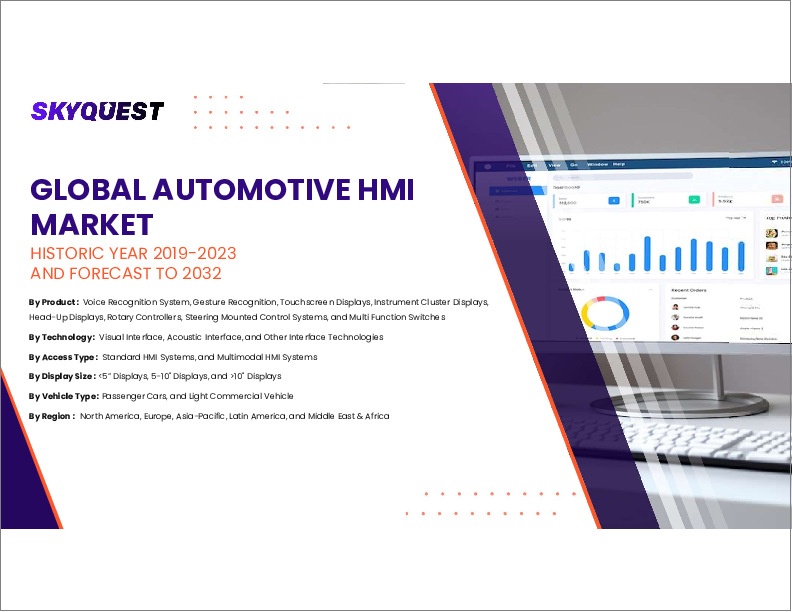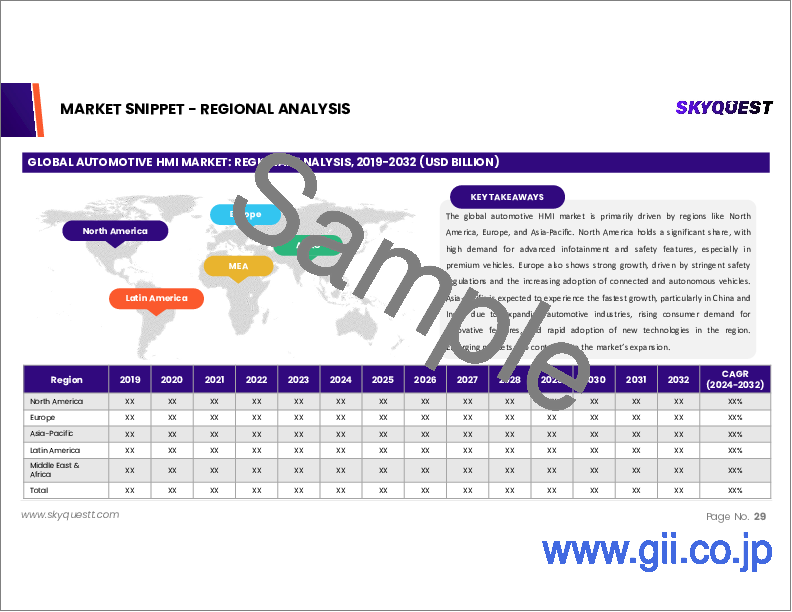|
|
市場調査レポート
商品コード
1607628
自動車用HMIの市場規模、シェア、成長分析、製品タイプ別、アクセスタイプ別、技術別、ディスプレイサイズ別、車両タイプ別、地域別 - 産業予測、2024年~2031年Automotive HMI Market Size, Share, Growth Analysis, By Product (Touch Screen Display, heads up Display), By Access Type, By Technology, By Display Size, By Vehicle Type, By Region - Industry Forecast 2024-2031 |
||||||
|
|||||||
| 自動車用HMIの市場規模、シェア、成長分析、製品タイプ別、アクセスタイプ別、技術別、ディスプレイサイズ別、車両タイプ別、地域別 - 産業予測、2024年~2031年 |
|
出版日: 2024年12月04日
発行: SkyQuest
ページ情報: 英文 165 Pages
納期: 3~5営業日
|
全表示
- 概要
- 目次
世界の自動車用HMIの市場規模は2022年に224億米ドルと評価され、2023年の256億米ドルから2031年には652億米ドルに成長し、予測期間(2024-2031年)のCAGRは12.4'%で成長する見通しです。
高級品市場、特に高級自動車は、可処分所得の増加と生活水準の向上に牽引されて成長を遂げています。この動向は、先進的な自動車用ヒューマン・マシン・インターフェース(HMI)の需要を高めると予想されます。しかし、HMIシステムは複雑なため、早急なメンテナンスが必要であり、これが市場の課題となっています。逆に、自律走行車の台頭とジェスチャーベースのインタラクションの受け入れ拡大は、HMI需要をさらに高める。モノのインターネット(IoT)の普及は、マルチモーダルUXソリューションに新たな道を開く一方、無線アップデートやV2X(Vehicle-to-Everything)といった接続トレンドの進化は、有利な機会をもたらします。コスト効率の高いHMIとスマートフォンの統合や、車両管理におけるADAS(先進運転支援システム)の利用拡大も、市場促進要因・課題(システムコストの高さ、消費電力、サイバーセキュリティへの懸念など)にもかかわらず、市場拡大の原動力となると思われます。
目次
イントロダクション
- 調査の目的
- 調査範囲
- 定義
調査手法
- 情報調達
- 二次データと一次データの方法
- 市場規模予測
- 市場の前提条件と制限
エグゼクティブサマリー
- 世界市場の見通し
- 供給と需要の動向分析
- セグメント別機会分析
市場力学と見通し
- 市場概要
- 市場規模
- 市場力学
- 促進要因と機会
- 抑制要因と課題
- ポーター分析と影響
- 競争企業間の敵対関係
- 代替品の脅威
- 買い手の交渉力
- 新規参入業者の脅威
- 供給企業の交渉力
主な市場の考察
- 重要成功要因
- 競合の程度
- 主な投資機会
- 市場エコシステム
- 市場の魅力指数(2023年)
- PESTEL分析
- マクロ経済指標
- バリューチェーン分析
- 価格分析
- 技術の進歩
- 規制情勢
- ケーススタディ
- 特許分析
自動車用HMIの市場規模:製品別& CAGR(2024-2031)
- 市場概要
- 音声認識システム
- ロータリーコントローラー
- ジェスチャー認識
- タッチスクリーンディスプレイ
- インストルメントクラスターディスプレイ
- ステアリングマウントコントロールシステム
- ヘッドアップディスプレイ
- 多機能スイッチ
自動車用HMIの市場規模:アクセスタイプ別& CAGR(2024-2031)
- 市場概要
- 標準HMIシステム
- マルチモーダルHMIシステム
自動車用HMIの市場規模:技術別& CAGR(2024-2031)
- 市場概要
- ビジュアルインターフェース
- 音響インターフェース
- その他のインターフェース技術
自動車用HMIの市場規模:ディスプレイサイズ別& CAGR(2024-2031)
- 市場概要
- 5インチ未満
- 5-10インチ
- 10インチ超
自動車用HMIの市場規模:車両タイプ別& CAGR(2024-2031)
- 市場概要
- 乗用車
- 小型商用車
- 防衛と安全保障
- 農業
- 物流・輸送
- エネルギーと電力
- 建設・鉱業
- 保険
- 野生生物と林業
自動車用HMIの市場規模:地域別& CAGR(2024-2031)
- 北米
- 米国
- カナダ
- 欧州
- 英国
- ドイツ
- スペイン
- フランス
- イタリア
- その他欧州地域
- アジア太平洋
- 中国
- インド
- 日本
- 韓国
- その他アジア太平洋地域
- ラテンアメリカ
- ブラジル
- その他ラテンアメリカ地域
- 中東およびアフリカ
- GCC諸国
- 南アフリカ
- その他中東・アフリカ
競合情報
- 上位5社の比較
- 主要企業の市場ポジショニング(2023年)
- 主な市場企業が採用した戦略
- 市場の最近の動向
- 企業の市場シェア分析(2023年)
- 主要企業の企業プロファイル
- 会社概要
- 製品ポートフォリオ分析
- セグメント別シェア分析
- 収益の前年比比較(2021-2023)
主要企業プロファイル
- Continental AG(Germany)
- Robert Bosch(Germany)
- Valeo SA(France)
- Visteon Corporation(United States)
- Harman International Industries, Incorporated(United States)
- Panasonic Corporation(Japan)
- Delphi Automotive LLP(United Kingdom)
- Alpine Electronics, Inc.(Japan)
- Faurecia SA(France)
- Denso Corporation(Japan)
- Magneti Marelli S.p.A.(Italy)
- Alpine Electronics of America, Inc.(United States)
- Yazaki Corporation(Japan)
- Alpine Electronics GmbH(Germany)
- Preh GmbH(Germany)
- Mitsubishi Electric Corporation(Japan)
- Johnson Controls International plc(Ireland)
- Altran Technologies SA(France)
- Nuance Communications, Inc.(United States)
- Nippon Seiki Co., Ltd.(Japan)
結論と推奨事項
Global Automotive HMI Market size was valued at USD 22.4 billion in 2022 and is poised to grow from USD 25.6 billion in 2023 to USD 65.2 billion by 2031, growing at a CAGR of 12.4'% during the forecast period (2024-2031).
The luxury goods market, particularly high-end vehicles, is witnessing growth driven by increased disposable income and a rising standard of living. This trend is anticipated to bolster the demand for advanced automotive Human-Machine Interfaces (HMIs). However, the complexity of HMI systems necessitates urgent maintenance, posing a market challenge. Conversely, the ascent of autonomous vehicles and the growing acceptance of gesture-based interactions further enhance HMI demand. The Internet of Things (IoT) adoption opens new avenues for multimodal UX solutions, while evolving connectivity trends like over-the-air updates and vehicle-to-everything (V2X) present lucrative opportunities. The integration of cost-effective HMIs with smartphones and the rising utilization of Advanced Driver Assistance Systems (ADAS) in fleet management will also drive market expansion, despite challenges like high system costs, power consumption, and cybersecurity concerns.
Top-down and bottom-up approaches were used to estimate and validate the size of the Global Automotive Hmi market and to estimate the size of various other dependent submarkets. The research methodology used to estimate the market size includes the following details: The key players in the market were identified through secondary research, and their market shares in the respective regions were determined through primary and secondary research. This entire procedure includes the study of the annual and financial reports of the top market players and extensive interviews for key insights from industry leaders such as CEOs, VPs, directors, and marketing executives. All percentage shares split, and breakdowns were determined using secondary sources and verified through Primary sources. All possible parameters that affect the markets covered in this research study have been accounted for, viewed in extensive detail, verified through primary research, and analyzed to get the final quantitative and qualitative data.
Global Automotive Hmi Market Segmental Analysis
Global Automotive HMI Market is segmented by Product, Access Type, Technology, Display Size, Vehicle Type and Region. Based on Product, the market is segmented into Voice Recognition System, Rotary Controllers, Gesture Recognition, Touch Screen Display, Instrument Cluster Display, Steering Mounted Control System, Heads Up Display, Multifunction Switches. Based on Access Type, the market is segmented into Standard HMI, Multimodal HMI. Based on Technology, the market is segmented into Visual Interface, Acoustic Interface, Other Interface technologies. Based on Display Size, the market is segmented into <5", 5-10", >10". Based on Vehicle Type, the market is segmented into Passenger Cars, Light Commercial Vehicle. Based on Region, the market is segmented into North America, Europe, Asia Pacific, Latin America and Middle East & and Africa.
Driver of the Global Automotive Hmi Market
The global Automotive HMI market is being propelled by automobile manufacturers' commitment to enhancing user experience through cutting-edge UX/UI designs. This focus on innovation has significantly improved human-vehicle interaction, facilitating advancements in autonomous vehicle technology. The seamless integration of advanced functionalities into modern vehicle software is creating valuable opportunities within the automotive human-machine interface (HMI) sector. Manufacturers are prioritizing driver comfort and precision by combining these interfaces with sophisticated 2D and 3D visuals. As a result, the market is witnessing exponential growth, with stakeholders eager to capitalize on the evolving landscape of automotive technology and consumer expectations.
Restraints in the Global Automotive Hmi Market
The expansion of the global Automotive HMI market is being hindered by several factors, including the substantial expenses associated with advanced HMI systems, their significant power consumption, and the challenges linked to the maintenance of these complex technologies. Additionally, the looming risks related to cybersecurity further complicate the landscape, as they raise concerns about the safety and reliability of these systems. As manufacturers strive to innovate and meet consumer demands, the intersection of high costs, operational challenges, and security threats presents a formidable restraint on market growth, necessitating careful management and strategic planning to navigate these obstacles.
Market Trends of the Global Automotive Hmi Market
The Global Automotive Human-Machine Interface (HMI) market is witnessing a significant trend driven by increasing consumer demand for personalized in-vehicle digital experiences. This surge in customization is paving the way for innovative solutions in automotive HMI, particularly amidst advancements in Advanced Driver Assistance Systems (ADAS). According to a TMR analysis, the market is projected to expand at a compound annual growth rate (CAGR) of approximately 6% from 2021 to 2031, with a valuation exceeding US$ 16.3 billion in 2021. This growth reflects a broader shift towards integrating sophisticated technologies that enhance user interaction and safety, fostering new opportunities for manufacturers and tech innovators alike.
Table of Contents
Introduction
- Objectives of the Study
- Scope of the Report
- Definitions
Research Methodology
- Information Procurement
- Secondary & Primary Data Methods
- Market Size Estimation
- Market Assumptions & Limitations
Executive Summary
- Global Market Outlook
- Supply & Demand Trend Analysis
- Segmental Opportunity Analysis
Market Dynamics & Outlook
- Market Overview
- Market Size
- Market Dynamics
- Driver & Opportunities
- Restraints & Challenges
- Porters Analysis & Impact
- Competitive rivalry
- Threat of substitute
- Bargaining power of buyers
- Threat of new entrants
- Bargaining power of suppliers
Key Market Insights
- Key Success Factors
- Degree of Competition
- Top Investment Pockets
- Market Ecosystem
- Market Attractiveness Index, 2023
- PESTEL Analysis
- Macro-Economic Indicators
- Value Chain Analysis
- Pricing Analysis
- Technological Advancement
- Regulatory Landscape
- Case Studies
- Patent Analysis
Automotive HMI Market Size by Product & CAGR (2024-2031)
- Market Overview
- Voice Recognition System
- Rotary Controllers
- Gesture Recognition
- Touch Screen Display
- Instrument Cluster Display
- Steering Mounted Control System
- Heads Up Display
- Multifunction Switches
Automotive HMI Market Size by Access Type & CAGR (2024-2031)
- Market Overview
- Standard HMI System
- Multimodal HMI System
Automotive HMI Market Size by Technology & CAGR (2024-2031)
- Market Overview
- Visual Interface
- Acoustic Interface
- Other Interface Technologies
Automotive HMI Market Size by Display Size & CAGR (2024-2031)
- Market Overview
- <5"
- 5-10"
- >10"
Automotive HMI Market Size by Vehicle type & CAGR (2024-2031)
- Market Overview
- Passenger Cars
- Light Commercial Vehicles
- Defence and Security
- Agriculture
- Logistics and Transportation
- Energy and Power
- Construction and Mining
- Insurance
- Wildlife and Forestry
Automotive HMI Market Size & CAGR (2024-2031)
- North America, (Product, Access Type, Technology, Display Size, Vehicle Type)
- US
- Canada
- Europe, (Product, Access Type, Technology, Display Size, Vehicle Type)
- UK
- Germany
- Spain
- France
- Italy
- Rest of Europe
- Asia-Pacific, (Product, Access Type, Technology, Display Size, Vehicle Type)
- China
- India
- Japan
- South Korea
- Rest of Asia Pacific
- Latin America, (Product, Access Type, Technology, Display Size, Vehicle Type)
- Brazil
- Rest of Latin America
- Middle East & Africa, (Product, Access Type, Technology, Display Size, Vehicle Type)
- GCC Countries
- South Africa
- Rest of Middle East & Africa
Competitive Intelligence
- Top 5 Player Comparison
- Market Positioning of Key Players, 2023
- Strategies Adopted by Key Market Players
- Recent Developments in the Market
- Company Market Share Analysis, 2023
- Company Profiles of All Key Players
- Company Details
- Product Portfolio Analysis
- Company's Segmental Share Analysis
- Revenue Y-O-Y Comparison (2021-2023)
Key Company Profiles
- Continental AG (Germany)
- Company Overview
- Business Segment Overview
- Financial Updates
- Key Developments
- Robert Bosch (Germany)
- Company Overview
- Business Segment Overview
- Financial Updates
- Key Developments
- Valeo SA (France)
- Company Overview
- Business Segment Overview
- Financial Updates
- Key Developments
- Visteon Corporation (United States)
- Company Overview
- Business Segment Overview
- Financial Updates
- Key Developments
- Harman International Industries, Incorporated (United States)
- Company Overview
- Business Segment Overview
- Financial Updates
- Key Developments
- Panasonic Corporation (Japan)
- Company Overview
- Business Segment Overview
- Financial Updates
- Key Developments
- Delphi Automotive LLP (United Kingdom)
- Company Overview
- Business Segment Overview
- Financial Updates
- Key Developments
- Alpine Electronics, Inc. (Japan)
- Company Overview
- Business Segment Overview
- Financial Updates
- Key Developments
- Faurecia SA (France)
- Company Overview
- Business Segment Overview
- Financial Updates
- Key Developments
- Denso Corporation (Japan)
- Company Overview
- Business Segment Overview
- Financial Updates
- Key Developments
- Magneti Marelli S.p.A. (Italy)
- Company Overview
- Business Segment Overview
- Financial Updates
- Key Developments
- Alpine Electronics of America, Inc. (United States)
- Company Overview
- Business Segment Overview
- Financial Updates
- Key Developments
- Yazaki Corporation (Japan)
- Company Overview
- Business Segment Overview
- Financial Updates
- Key Developments
- Alpine Electronics GmbH (Germany)
- Company Overview
- Business Segment Overview
- Financial Updates
- Key Developments
- Preh GmbH (Germany)
- Company Overview
- Business Segment Overview
- Financial Updates
- Key Developments
- Mitsubishi Electric Corporation (Japan)
- Company Overview
- Business Segment Overview
- Financial Updates
- Key Developments
- Johnson Controls International plc (Ireland)
- Company Overview
- Business Segment Overview
- Financial Updates
- Key Developments
- Altran Technologies SA (France)
- Company Overview
- Business Segment Overview
- Financial Updates
- Key Developments
- Nuance Communications, Inc. (United States)
- Company Overview
- Business Segment Overview
- Financial Updates
- Key Developments
- Nippon Seiki Co., Ltd. (Japan)
- Company Overview
- Business Segment Overview
- Financial Updates
- Key Developments






